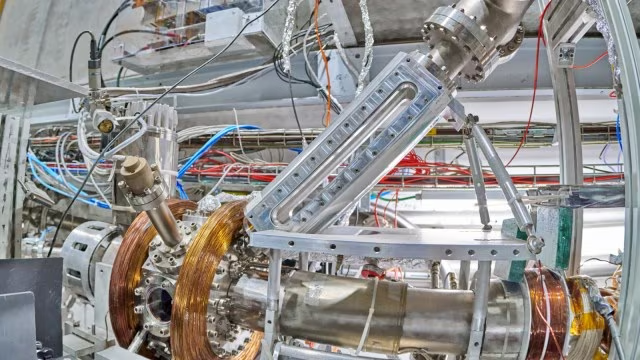Description

Disclaimer: Copyright infringement not intended.
Context
In a first, an international team of physicists from the Anti-hydrogen Experiment: Gravity, Interferometry, Spectroscopy (AEgIS) collaboration has achieved a breakthrough by demonstrating the laser cooling of Positronium.
Details
- Unique Properties of Positronium: Positronium has a very short half-life of 142 nanoseconds and a mass twice that of an electron. It is a pure leptonic atom, making it an excellent candidate for fundamental physics experiments.
- Experimental Setting: The experiment took place at CERN, the European Organization for Nuclear Research, in Geneva. It represents a crucial step towards understanding anti-Hydrogen formation and measuring Earth's gravitational acceleration on antihydrogen.
- Technical Challenges: The experiment was conducted under challenging conditions in an accelerator beam hall, requiring technological innovations in various aspects such as laser systems, alignment, timing, and detection techniques.
- Results: The laser cooling process reduced the temperature of Positronium atoms from approximately 380 Kelvin to about 170 Kelvin, demonstrating one-dimensional cooling using a 70-nanosecond pulse of the alexandrite-based laser system.
- Future Implications: Physicists anticipate that this achievement will pave the way for spectroscopic comparisons essential for Quantum Electrodynamics (QED) studies and potentially lead to the creation of a positronium Bose–Einstein condensate.
- Potential Applications: A positronium Bose–Einstein condensate could serve as a powerful tool for both fundamental and applied research, including high-precision measurements of antimatter properties and the production of coherent gamma-ray light for peering into atomic nuclei.

What is Positronium?
- Definition: Positronium is a bound state consisting of an electron and its antiparticle, the positron.
- Classification: It's often considered an exotic atom or a pseudo-atom, as it behaves similarly to a hydrogen atom but with a reduced mass.
Properties of Positronium:
- Varieties: There are two forms of positronium: ortho-positronium (o-Ps) and para-positronium (p-Ps), based on their spins.
- Spin States:
- Ortho-positronium: Spins of the electron and positron are parallel (triplet state).
- Para-positronium: Spins are anti-parallel (singlet state).
- Lifetime: Positronium has a very short lifetime, typically on the order of nanoseconds, before annihilating into gamma rays.
- Annihilation: When positronium annihilates, it produces two or three gamma-ray photons with energies of 511 keV each, as the total rest energy of the electron-positron pair is converted into photons.
Formation and Detection:
- Formation: Positronium can form through the collision of a positron and an electron, typically in a low-energy environment.
- Detection Methods:
- Time-of-flight measurements.
- Annihilation gamma-ray spectroscopy.
- Positronium beam experiments.
- Positronium laser experiments.
Applications and Significance:
- Fundamental Physics: Studying positronium helps understand the behavior of matter-antimatter systems and test fundamental symmetries such as charge conjugation and parity symmetry.
- Quantum Electrodynamics (QED): Positronium is a valuable testing ground for quantum electrodynamics predictions and calculations.
- Positronium Chemistry: Positronium can interact with other atoms and molecules similarly to how electrons do, providing insights into chemical processes and material properties.
- Antimatter Research: Positronium serves as a model system for understanding more complex antimatter interactions and phenomena.
Challenges and Future Directions:
- Lifetime Extension: Efforts to create long-lived positronium states for practical applications.
- Exotic Positronium: Exploring positronium in extreme conditions, such as in plasmas or under high pressures.
- Positronium Hydride: Theoretical studies and experimental efforts to create and study positronium hydride (PsHPsH), an analog to the hydrogen molecule.
- Quantum Computing: Speculations on the potential use of positronium in quantum computing due to its unique properties.
About AEgIS
- The Antihydrogen Experiment: Gravity, Interferometry, Spectroscopy (AEgIS) aims to directly measure the Earth's gravitational acceleration, g, on antihydrogen.
- This experiment is conducted by a collaboration of physicists from various countries in Europe and India.
- The primary objective of AEgIS is to measure the strength of the gravitational interaction between matter and antimatter, specifically antihydrogen, with high precision.
- This involves measuring the acceleration experienced by antihydrogen due to Earth's gravity.
Experimental Setup:
- Antiproton Decelerator: AEgIS utilizes antiprotons from the Antiproton Decelerator to create a pulsed beam of antihydrogen atoms.
- Moire Deflectometer: The antihydrogen beam is passed through a Moire deflectometer coupled to a position-sensitive detector. This instrument helps measure the gravitational interaction between antihydrogen and Earth.
- Grating System: A system of gratings in the deflectometer splits the antihydrogen beam into parallel rays, forming a periodic pattern. This pattern is crucial for measuring the drop in the beam's height during horizontal flight.
- Measurement: By analyzing the shift in the periodic pattern and the time taken by each antihydrogen atom to fly and fall, the AEgIS team can determine the strength of the gravitational force between Earth and antihydrogen.

Achievements:
- In 2018, AEgIS demonstrated the first pulsed production of antihydrogen atoms.
- This milestone was achieved by interacting pulse-produced positronium with cold, trapped antiprotons.
- The ability to produce pulsed antihydrogen beams is a crucial step towards the experiment's main goal.
Conclusion
Positronium stands as a unique and valuable system in the study of particle physics, offering insights into fundamental interactions, antimatter behavior, and potential applications in fields ranging from fundamental research to materials science and quantum computing. Ongoing research continues to deepen our understanding of positronium and its implications in various domains of physics.
|
PRACTICE QUESTION
Q. AEgIS represents a significant endeavor in the field of antimatter research, aiming to deepen our understanding of gravitational interactions and fundamental physics principles. Comment. (250 words)
|
















